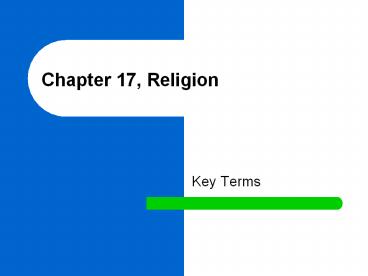Chapter 17, Religion - PowerPoint PPT Presentation
Title:
Chapter 17, Religion
Description:
Chapter 17, Religion Key Terms sacred That which is set apart from ordinary activity. profane That which is of the everyday world and is specifically not religious. – PowerPoint PPT presentation
Number of Views:222
Avg rating:3.0/5.0
Title: Chapter 17, Religion
1
Chapter 17, Religion
- Key Terms
2
- sacredThat which is set apart from ordinary
activity. - profaneThat which is of the everyday world and
is specifically not religious.
3
- totemAn object or living thing that a religious
group regards with special awe and reverence. - secularOrdinary beliefs of everyday life.
4
- religiosityThe intensity and consistency of
practice of a persons (or groups) faith. - monotheistsThe worship of a single god.
5
- polytheistsWorship of more than one deity.
- patriarchal religionsBeliefs and practices are
based on male power and authority.
6
- matriarchal religionsBased on the centrality of
female goddesses, who may be seen as the source
of food, nurturance, and love or who may serve as
emblems of the power of women. - exclusive religious groups Those with an easily
identifiable religion and culture, including
distinctive beliefs and strong moral teachings.
7
- inclusive religious groupsThose with a more
moderate, liberal, and ecumenical religious
orientation. - ritualsSymbolic activities that express a
group's spiritual convictions.
8
- collective consciousness.Body of beliefs that
are common to a community or society and that
give people a sense of belonging. - Protestant ethicBelief that hard work and
self-denial lead to salvation.
9
- ideologyBelief systems that legitimates the
social order and supports the ideas of the ruling
class. - ethnoreligious groupsGroups for whom religion
and ethnicity are especially intertwined. Two
examples are Hasidic Jews and the Amish.
10
- churchesFormal organizations that tend to see
themselves, and are seen by society, as the
primary and legitimate religious institutions. - sectsGroups that have broken off from an
established church, when a faction questions the
legitimacy or purity of the church from which
they are separating.
11
- cultsReligious groups devoted to a specific
cause or a leader with charisma, and are like
sects in their emotional intensity. - charismaA quality attributed to individuals
believed by their followers to have special
powers.
12
- religious socializationThe process by which one
learns a particular religious faith. - brainwashing thesisClaim that innocent people
are tricked into religious conversion.
13
- social drift theoryEmphasizing that conversion
is linked to shifting patterns of association and
that people are active participants in the
conversion process. - antisemitism The belief or behavior that defines
Jewish people as inferior and then targets them
for stereotyping, mistreatment and acts of
hatred.
14
- secularizationThe process by which religious
institutions, behavior and consciousness lose
their religious significance. - rationalization of societySociety is
increasingly organized around rational,
empirical, and scientific forms of thought.































